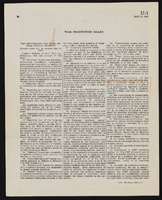Search the Special Collections and Archives Portal
Search Results
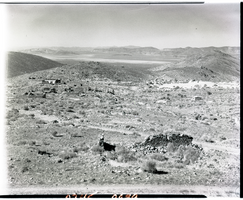
Film transparency of a ghost town, Delamar, Nevada, 1956
Date
Archival Collection
Description
Image

Film transparency of a ghost town, Delamar, Nevada, 1956
Date
Archival Collection
Description
Image
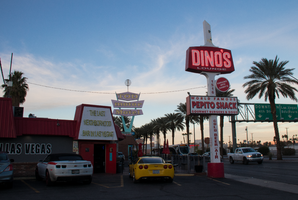
Photographs of Dino's Lounge sign, Las Vegas (Nev.), February 19, 2017
Date
Archival Collection
Description
Site address: 1516 S Las Vegas Blvd
Sign owner: Kristin Bartolo
Sign details: This location was originally constructed in 1957. Opened as Ringside Liquors by Eddie Trascher. Trascher sold the property to Rinaldo Dean "Dino" Bartolomucci in 1962. Bartolomucci Renamed it "Dino's". Bartolomucci sold cars in california, moved to Las Vegas in the 1950's. "Dino's" is now owned by his granddaughter Kristin Bartolo.
Sign condition: 4 out of 5, it still lights up brightly at night and has bright paint colors.
Sign form: Pylon as well as signage on the building.
Sign-specific description: Sign on building green cover filtered neon, with a script style design for the name. Road pylon contains skeletal neon with red and white design also stating their name "Dino's" in the same font as the sign on the building. This pylon has a white base that extends out of the main red rectangle portion of the sign. Also below their logo is a back lit plastic sign.
Sign - type of display: Neon (skeletal on roadside sign and encased on building) and Plastic Backlit sign
Sign - media: Steel and plastic.
Sign - non-neon treatments: Plastic back lit portion
Sign environment: This is located downtown just a few blocks south of Fremont, next to Tod Motor Motel.
Sign - date of installation: 1963
Sign - thematic influences: This sign shows 50's/60's trend with the base of the sign extending out of the main worded portion of the sign. That trend is very common among many other signs across the valley from the same era.
Survey - research locations: Dino's website http://dinoslv.com/new/, Recorder's office, Assessor's office, Dino's site visit and discussion with owner Kristin.
Survey - research notes: This location is .35 acres and was constructed 1957. The Dino's website contains an archive of images of their bar and owners from the last 50 years, and some of the images show older photos of their sign.
Surveyor: Wyatt Currie-Diamond
Survey - date completed: 2017-08-11
Sign keywords: Neon; Plastic; Backlit; Steel; Pole sign
Mixed Content
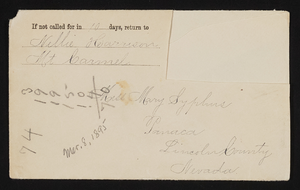
Letter and envelope from Nellie Harrison, Mt. Carmel to Mary Etta Syphus, Panaca, Nevada
Date
Archival Collection
Description
From the Syphus-Bunker Papers (MS-00169). The folder contains an original handwritten letter, a typed transcription of the same letter, the original envelope with the stamp removed, and a copy of the original letter.
Text
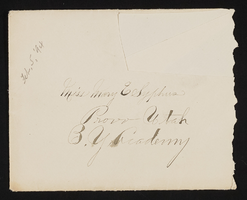
Letter and envelope from John M. Bunker, Logan, Utah. to Mary Etta Syphus, Provo, Utah
Date
Archival Collection
Description
From the Syphus-Bunker Papers (MS-00169). The folder contains an original handwritten letter, a typed transcription of the same letter, the original envelope with the stamp removed, and a copy of the original letter.
Text

Untitled unpublished manuscript by Roosevelt Fitzgerald
Date
Archival Collection
Description
From the Roosevelt Fitzgerald Professional Papers (MS-01082) -- Unpublished manuscripts file. "Injustice Blacks Have Suffered…" ending with Naomi Long Madgett's poem "Midway."
Text
Robert Scott Hooper Photographs [UNPROCESSED]
Identifier
Abstract
This collection is unprocessed; see the access note for additional information. The Robert Scott Hooper Photographs (approximately 1960-2019) consist of photographic negatives, positives, prints, Polaroids, 16mm films, videos, business records, correspondence, drawings, and ephemera. The collection was created by prolific photographer Robert Scott Hooper and his longtime business partner and wife, Theresa Holmes. The couple's life and business was based in Las Vegas, Nevada. Hooper's work focused on the female form, encompassing many areas of interest including sexual entertainment, modeling, pornography, and Las Vegas entertainment. Hooper was a contributing photographer with Playboy and Vegas Visitor magazines. Hooper also photographed many celebrities, Las Vegas production shows, notable events like hotel implosions, and the development of the Las Vegas Strip, including early time-lapse work on the Luxor Hotel and Casino and The Venetian. This collection also includes business records, model contracts, and correspondence.
Archival Collection

Report by Moapa Soil Conservation District on irrigation storage possibilities of Wells Siding, Bowman Reservoir, and adjacent basins, December 1944
Date
Archival Collection
Description
Results of a preliminary survey of irrigation storage potential of Wells Siding, Bowman Reservoir and other nearby sites.
Text


